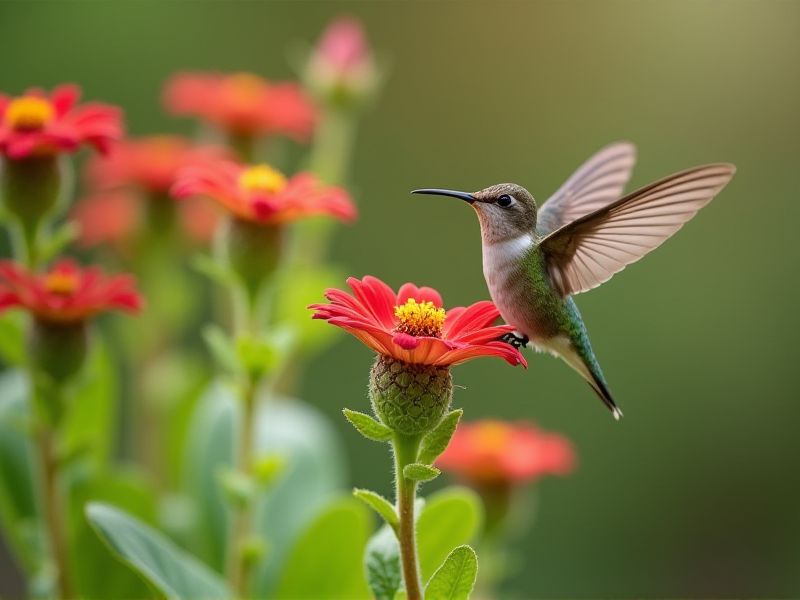
Choose native flowering plants such as bee balm (Monarda), salvia (Salvia spp.), and red columbine (Aquilegia canadensis) to attract hummingbirds. These species provide essential nectar rich in carbohydrates, vital for sustaining these energetic birds. Planting them in clusters enhances visibility and accessibility for hummingbirds, increasing their chances of visiting. You can also consider adding fuchsia (Fuchsia magellanica) and trumpet vine (Campsis radicans) for vibrant colors and added nectar sources. Ensuring a variety of bloom times will create a consistent food supply throughout the hummingbird migration season.
List of some Small plants that attract hummingbirds
- Scarlet Sage (Salvia coccinea)
- Coral Honeysuckle (Lonicera sempervirens)
- Bee Balm (Monarda didyma)
- Mexican Bush Sage (Salvia leucantha)
- Firecracker Plant (Russelia equisetiformis)
- Cardinal Flower (Lobelia cardinalis)
- Hummingbird Mint (Agastache rupestris)
- Pineapple Sage (Salvia elegans)
- Fuchsia (Fuchsia magellanica)
- Trumpet Creeper (Campsis radicans)
Important things about Small plants that attract hummingbirds
Nectar-Rich Flowers
Small plants that attract hummingbirds often feature vibrant, nectar-rich flowers that provide an essential food source for these pollinators. Species such as salvia, columbine, and bee balm not only boast bright, tubular blossoms but also thrive in a variety of garden settings, making them ideal for small landscapes. These plants typically bloom throughout the growing season, ensuring a continuous supply of nectar. By incorporating these hummingbird-friendly plants into your garden, you create a beautiful and dynamic environment that supports local wildlife.
Bright Colored Blooms
Small plants like salvia, bee balm, and columbine are excellent choices for attracting hummingbirds to your garden. These vibrant flowers produce tubular blossoms rich in nectar, making them irresistible to these agile aviators. Positioning these plants in sunny areas enhances their visibility and provides optimal conditions for growth. By incorporating a mix of these nectar-rich species, you can create a lively and colorful habitat that invites hummingbirds to visit regularly.
Native Plant Varieties
Consider incorporating native plants such as bee balm (Monarda didyma), which flourishes in sunny spots and produces vibrant red or pink flowers that are highly attractive to hummingbirds. Another excellent option is the columbine (Aquilegia canadensis), showcasing unique, tubular blossoms that offer easy access to nectar. The cardinal flower (Lobelia cardinalis) is also a fantastic choice; its striking red blooms not only draw hummingbirds but also thrive near water sources. Planting these native species in your garden can create a vibrant ecosystem that supports local wildlife and enhances your outdoor space.
Continuous Blooming Season
Small plants that bloom continuously throughout the growing season can create an enchanting garden while attracting hummingbirds with their vibrant flowers. Species like Salvia, particularly Salvia guaranitica and Salvia nemorosa, are excellent choices due to their tubular structure and rich nectar, inviting these pollinators to frequent your space. Additionally, plants such as Cuphea, commonly known as cigar plant, produce bright red and purple blooms that are particularly appealing to hummingbirds. Incorporating these varieties into your garden ensures a steady supply of food for hummingbirds, enhancing both their habitat and your enjoyment of nature.
Low Maintenance Care
Consider incorporating small plants like salvia, bee balm, and penstemon into your garden to attract hummingbirds. These low-maintenance options thrive in various conditions, requiring minimal watering and care once established. Their vibrant flowers provide a rich source of nectar, making them irresistible to these pollinators. By selecting native varieties, you can create a sustainable habitat that supports local wildlife while enhancing your outdoor space.
Planting In Clusters
Planting in clusters can create vibrant habitats that effectively attract hummingbirds, enhancing your garden's beauty and ecological value. Small plants like salvia, lavender, and bee balm are particularly effective, providing essential nectar sources for these energetic pollinators. By grouping these plants together, you not only create a visually appealing display but also facilitate easier foraging for hummingbirds. Ensuring diverse colors and blooms throughout the growing season will encourage repeated visits from these delightful birds, enriching your outdoor experience.
Sunlight Requirements
Small plants that attract hummingbirds typically thrive in full sun, requiring at least six hours of direct sunlight daily. Popular options include salvia, bee balm, and columbine, all of which provide vibrant blooms rich in nectar. When selecting these plants, consider their blooming season to ensure continuous food sources for your visiting hummingbirds throughout the growing period. Incorporating a variety of these sun-loving plants in your garden not only enhances its aesthetic appeal but also supports local pollinators.
Humidity Preferences
Small plants that attract hummingbirds thrive in moderate to high humidity levels, providing the ideal environment for their vibrant blooms. Varieties such as a miniature Salvia or Lobelia are particularly beloved, as they not only offer nectar-rich flowers but also flourish in humid conditions. Ensuring consistent moisture in the soil and surrounding air enhances the plant's health, making them more appealing to hummingbirds. By creating a humidity-friendly garden space with these captivating plants, you can attract these colorful birds while enjoying the beauty of their presence.
Soil Drainage Needs
Small plants that attract hummingbirds thrive best in well-drained soil, which prevents waterlogging that can damage root systems. Plants like salvia, lobelia, and penstemon are excellent choices, as their vibrant flowers provide nectar while their compact size fits easily into smaller garden spaces. Always ensure your selected plants have proper drainage to maintain healthy growth and sustained blooming throughout the season. Incorporating these plants not only enhances your landscape but also creates a lively environment for these fascinating birds.
Avoiding Pesticides
Small plants that attract hummingbirds provide a vibrant and eco-friendly gardening option, allowing you to enjoy their beauty while supporting local ecosystems. Native species like monarda (bee balm), salvia (sage), and columbine offer nectar-rich flowers, perfect for enticing these pollinators without the negative impact of pesticides. To create a hummingbird-friendly habitat, consider incorporating plants like agastache or fuchsia, which thrive in sunny or partially shaded areas. By choosing these pesticide-free options, you not only nurture your garden but also contribute to the conservation of these essential birds.
